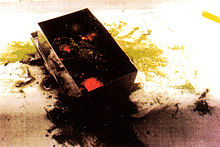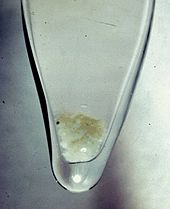Plutonium compounds

Plutonium compounds are compounds containing the element plutonium (Pu). At room temperature, pure plutonium is silvery in color but gains a tarnish when oxidized.[1] The element displays four common ionic oxidation states in aqueous solution and one rare one:[2]
- Pu(III), as Pu3+ (blue lavender)
- Pu(IV), as Pu4+ (yellow brown)
- Pu(V), as PuO+
2 (light pink)[note 1] - Pu(VI), as PuO2+
2 (pink orange) - Pu(VII), as PuO3−
5 (green)-the heptavalent ion is rare.
The color shown by plutonium solutions depends on both the oxidation state and the nature of the acid
A +8 oxidation state is possible as well in the volatile tetroxide PuO
4.[6] Though it readily decomposes via a reduction mechanism similar to FeO
4, PuO
4 can be stabilized in alkaline solutions and chloroform.[7][6]
Metallic plutonium is produced by reacting


Plutonium is a reactive metal. In moist air or moist argon, the metal oxidizes rapidly, producing a mixture of oxides and hydrides.[11] If the metal is exposed long enough to a limited amount of water vapor, a powdery surface coating of PuO2 is formed.[11] Also formed is plutonium hydride but an excess of water vapor forms only PuO2.[9]
Plutonium shows enormous, and reversible, reaction rates with pure hydrogen, forming plutonium hydride.[12] It also reacts readily with oxygen, forming PuO and PuO2 as well as intermediate oxides; plutonium oxide fills 40% more volume than plutonium metal. The metal reacts with the halogens, giving rise to compounds with the general formula PuX3 where X can be F, Cl, Br or I and PuF4 is also seen. The following oxyhalides are observed: PuOCl, PuOBr and PuOI. It will react with carbon to form PuC, nitrogen to form PuN and silicon to form PuSi2.[2][10]
The organometallic chemistry of plutonium complexes is typical for organoactinide species; a characteristic example of an organoplutonium compound is plutonocene.[13][14] Computational chemistry methods indicate an enhanced covalent character in the plutonium-ligand bonding.[12][14]
Powders of plutonium, its hydrides and certain oxides like Pu2O3 are pyrophoric, meaning they can ignite spontaneously at ambient temperature and are therefore handled in an inert, dry atmosphere of nitrogen or argon. Bulk plutonium ignites only when heated above 400 °C. Pu2O3 spontaneously heats up and transforms into PuO2, which is stable in dry air, but reacts with water vapor when heated.[15]
Crucibles used to contain plutonium need to be able to withstand its strongly reducing properties. Refractory metals such as tantalum and tungsten along with the more stable oxides, borides, carbides, nitrides and silicides can tolerate this. Melting in an electric arc furnace can be used to produce small ingots of the metal without the need for a crucible.[9]
Cerium is used as a chemical simulant of plutonium for development of containment, extraction, and other technologies.[16]
See also
Notes
- ^ The PuO+
2 ion is unstable in solution and will disproportionate into Pu4+ and PuO2+
2; the Pu4+ will then oxidize the remaining PuO+
2 to PuO2+
2, being reduced in turn to Pu3+. Thus, aqueous solutions of PuO+
2 tend over time towards a mixture of Pu3+ and PuO2+
2. UO+
2 is unstable for the same reason.[3]
References
- ISBN 0-8306-3018-X.
- ^ ISBN 0-8493-0487-3.
- ^ Crooks, William J. (2002). "Nuclear Criticality Safety Engineering Training Module 10 – Criticality Safety in Material Processing Operations, Part 1" (PDF). Archived from the original (PDF) on March 20, 2006. Retrieved February 15, 2006.
- ^ Matlack, George (2002). A Plutonium Primer: An Introduction to Plutonium Chemistry and its Radioactivity. Los Alamos National Laboratory. LA-UR-02-6594.
- PMID 28235179.
- ^ PMID 23883027.
- S2CID 100915090.
- ISBN 978-3-11-011451-5.
- ^ LCCN 68029938.
- ^ ISBN 0-19-850340-7.
- ^ a b "Plutonium, Radioactive". Wireless Information System for Emergency Responders (WISER). Bethesda (MD): U.S. National Library of Medicine, National Institutes of Health. Archived from the original on August 13, 2011. Retrieved November 23, 2008. (public domain text)
- ^ a b Hecker, Siegfried S. (2000). "Plutonium and its alloys: from atoms to microstructure" (PDF). Los Alamos Science. 26: 290–335. Archived (PDF) from the original on February 24, 2009. Retrieved February 15, 2009.
- ISBN 0-7506-3365-4.
- ^ PMID 28371148.
- ^ "Primer on Spontaneous Heating and Pyrophoricity – Pyrophoric Metals – Plutonium". Washington (DC): U.S. Department of Energy, Office of Nuclear Safety, Quality Assurance and Environment. 1994. Archived from the original on April 28, 2007.
- from the original on June 14, 2011. Retrieved January 24, 2010.
